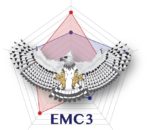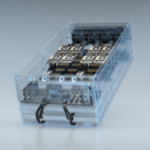Just over a year after Los Alamos National Laboratory launched the Efficient Mission Centric Computing Consortium (EMC3), 15 companies, universities and federal organizations are now working together to explore new ways to make extreme-scale computers more efficient. “In the first year of EMC3 we have already seen efficiency improvements to HPC in a number of areas, including the world’s first NVMe-based hardware-accelerated compressed parallel filesystem, in-situ analysis enabled on network adapters for a real simulation code, identifying issues with file system metadata performance in the Linux Kernel, record-setting in situ simulation output indexing, demonstrating file-system metadata indexing, and more.”
ORNL Tests Arm-based Wombat Platform with NVIDIA GPUs
Researchers at ORNL are trying out their HPC codes on Wombat, a test bed cluster based on production Marvell ThunderX2 CPUs and NVIDIA V100 GPUs. The small cluster provides a platform for testing NVIDIA’s new CUDA software stack purpose-built for Arm CPU systems. “Eight teams successfully ported their codes to the new system in the days leading up to SC19. In less than 2 weeks, eight codes in a variety of scientific domains were running smoothly on Wombat.”
Brent Gorda from Arm looks back at ISC 2019
In this special guest feature, Brent Gorda from Arm shares his impressions of ISC 2019 in Frankfurt. “From the perspective of Arm in HPC, it was an excellent event with several high-profile announcements that caught everyone’s attention. The Arm ecosystem was well represented with our partners visible on the show floor and around town.”
Podcast: Radio Free HPC Runs Down the TOP500
In this podcast, the Radio Free HPC team reviews the new TOP500 list of most powerful supercomputers. “Not much changed in the TOP10 but a lot is changing further down the list. The overwhelming majority of the systems, 478 of them, are based on Intel CPUs. 13 are IBM, and there is 1 system based on Arm provided by Cavium, now part of Marvell.”
A Look Ahead at Disruptive Technologies for HPC
In this special guest feature from Scientific Computing World, Robert Roe looks at technology that could disrupt the HPC ecosystem. “As the HPC industry reaches the end of technology scaling based on Moore’s Law, system designers and hardware manufacturers must look towards more complex technologies that can replace the gains in performance provided by transistor scaling.”
Video: Deploying Marvell’s ThunderX2 at Scale in HPC Market
In this video from DDN booth at SC18, Larry Wikelius from Marvell presents: Deploying Marvell’s ThunderX2 at Scale in HPC Market. “The ThunderX2 product family is the company’s second-generation 64-bit ARMv8-A server processor SoCs for datacenter, cloud and high-performance computing (HPC) applications. The family integrates fully out-of-order, high-performance custom cores supporting single- and dual-socket configurations. ThunderX2 is optimized to drive high computational performance delivering outstanding memory bandwidth and memory capacity.”








